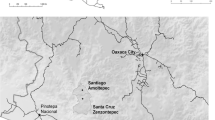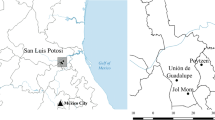Abstract
Theory and empirical data suggest the areas of origin of a crop to be the general area of origin of its coevolved weeds. These longer evolved weeds would have an advantage over species with a shorter evolutionary time and migrate more successfully. We seek to identify patterns by comparing two regions with a shared crop, similar physiographic traits, but little direct contact, one of which is the area of origin of the crop. We compared the diversity of the maize weed flora and its edible components between two rural villages each of Oaxaca, Mexico, and Honde Valley, Zimbabwe, using vegetation sampling, interviews and participatory observation. The Mexican fields had higher species richness and diversity than the Zimbabwean ones. Species richness and densities were higher in the villages that receive more rainfall. Mexican fields had a mainly native weed flora with almost 80% American species and very few of African origin, whereas Zimbabwe had 32% of American and 50% of African origin. The regions shared seven American species and one of African origin. American/Mesoamerican agrestal weeds appear to be more successful in maize. Subsistence farmers in both study areas consumed about 19 edible weed species of which four were common to all villages. Our results also suggest that the presence of 3–4 species of edible weeds per field may be a general pattern in the maize-based systems, and that people not necessarily want or need more, so usefulness—at least as an edible plant—would have a limited influence on migration success.


Similar content being viewed by others
References
Altieri MA, Merrick LC, Kat Anderson M (1987) Peasant agriculture and the conservation of crop and wild plant resources. Conserv Biol 1(1):49–57. doi:10.1111/j.1523-1739.1987.tb00008.x
Anderson I, Moyo M, Brinn PJ (1993) Physical resource inventory of the communal lands of Zimbabwe: an overview. Natural Resources Institute NRI Bulletin 60, Chatham
Asfaw Z, Tadesse M (2001) Prospects for sustainable use and development of wild food plants in Ethiopia. Econ Bot 55(1):47–62
Baker HG (1974) The evolution of weeds. Annu Rev Ecol Syst 5:1–24. doi:10.1146/annurev.es.05.110174.000245
Baker HG, Stebbins GL (1965) The genetics of colonizing species. Academic Press, New York
Calderón de Rzedowski G, Rzedowski J (2004) Manual de malezas de la región de Salvatierra, Guanajuato. Flora del Bajío y de regiones adyacentes. Fascículo Complementario XX. Instituto de Ecología, Jalapa, Mexico
Chacón JC, Gliessman SR (1982) Use of the non-weed concept in traditional tropical agroecosytems of South-Eastern Mexico. Agro-Ecosystems 8:1–11. doi:10.1016/0304-3746(82)90010-5
Chatizwa I, Vorage R (2000) Research on weed control using animal power undertaken by the Institute of Agricultural Engineering, Zimbabwe. In: Starkey P, Simalenga T (eds) Animal power for weed control. A resource book for the Animal Traction Network for Eastern and Southern Africa. Technical Centre for Agricultural and Rural Cooperation, Wageningen
Chivinge OA (1990) Weed science technological needs for the communal areas of Zimbabwe. Zambezia 17:133–143
Dafni A, Heller D (1980) The threat posed by alien weeds in Israel. Weed Res 20:277–283. doi:10.1111/j.1365-3180.1980.tb01619.x
Diaz-Betancourt M, Ghermandi L, Ladio A, Lopez-Moreno IR, Raffaele E, Rapoport EH (1999) Weeds as a source for human consumption. A comparison between tropical and temperate Latin America. Rev Biol Trop 47:329–338
Dovie DBK, Shackleton CM, Witkowski ETF (2007) Conceptualizing the human use of wild edible herbs for conservation in South African communal areas. J Environ Manag 84:146–156. doi:10.1016/j.jenvman.2006.05.017
Ellenberg H (1996) Vegetation Mitteleuropas mit den Alpen, 5th edn. Ulmer, Stuttgart
Espinosa-García FJ, Díaz-Pérez R (1996) El uso campesino de plantas arvenses como forraje en el Valle de México. Etnoecologia 3:83–94
Gamboa-Ruiz A (2004) Vegetación arvense y etnobotánica de las milpas de Cuquio, Jalisco, México. MSc thesis, Colegio de Postgraduados, Mexico
Gatsi T, Kanyungwe K, Makanganise A, Mabasa S (2001) Economics of integrated tillage and weed control practices on maize-based systems in the smallholder farming sector of Zimbabwe. In: Friesen DK, Palmer AFE (eds) Integrated approaches to higher maize productivity in the New Millennium. Proceedings of the 7th Eastern and Southern Africa regional maize conference, Nairobi, February 2002, pp 491–494
González-Amaro RM (2008) Productividad y valor económico potencial de arvenses en los cultivos de maíz de Nanacamilpa, Tlaxcala. MSc thesis, Colegio de Postgraduados, Mexico
Gray A (1879) The pertinacity and predominance of weeds. J Sci Arts 118:161–167
Grivetti LE, Ogle BM (2000) Value of traditional foods in meeting macro- and micronutrient needs: the wild plant connection. Nutr Res Rev 13:31–46. doi:10.1079/095442200108728990
Hairston NG, Ellner SP, Geber MA, Yoshida T, Fox JA (2005) Rapid evolution and the convergence of ecological and evolutionary time. Ecol Lett 8:1114–1127. doi:10.1111/j.1461-0248.2005.00812.x
Henderson PA, Seaby RHM (1998) Species diversity and richness, version 2.2. Pisces Conservation Ltd, Lymington
High C, Shackleton CM (2000) The comparative value of wild and domestic plants in home gardens of a South African rural village. Agrofor Syst 48:141–156. doi:10.1023/A:1006247614579
Hillocks RJ (1998) The potential benefits of weeds with reference to small holder agriculture in Africa. Integr Pest Manag Rev 3:155–167. doi:10.1023/A:1009698717015
Hyvönen T, Salonen J (2002) Weed diversity and community composition in cropping practices at two intensity levels—a six-year experiment. Plant Ecol 159:73–81
Keding G, Weinberger K, Swai I, Mndiga H (2007) Diversity, traits and use of traditional vegetables in Tanzania. Technical bulletin no. 40. AVRDC-The World Vegetable Center Shanhua, Taiwan
Kunkel G (1981) The use of the useless. GeoJournal 5:171–178. doi:10.1007/BF02582050
Linares E, Bye R (1992) Los principales quelites de México. In: Linares E, Aguirre J (eds) Los quelites un tesoro culinario. Universidad Nacional Autónoma de México and Instituto Nacional de Nutrición “Salvador Zubirán”, DF
Marshall F (2001) Agriculture and use of wild and weedy greens by the Piik Ap Oom Okiek of Kenya. Econ Bot 55(1):32–46
Marshall EJP, Brown K, Boatman ND, Lutman PJW, Squire GR, Ward LD (2003) The role of weeds in supporting biological diversity within crop fields. Weed Res 43:77–89. doi:10.1046/j.1365-3180.2003.00326.x
McCann JC (2005) Maize and grace. Africa’s encounter with a New World crop, 1500–2000. Harvard University Press, Cambridge
McGregor J (1995) Gathered produce in Zimbabwe’s communal areas changing resource availability and use. Ecol Food Nutr 33:163–193
Modi M, Modi A, Hendricks S (2006) Potential role for wild vegetables in household food security: A preliminary case study in KwaZulu -Natal, South Africa. Afr J Food Agri Nutr Dev 6 (1). Available via: http://www.ajfand.net/Issue-X-files/pdfs/AJFANDvol6no1PRA1.pdf Cited 16 Oct 2008
Moles AT, Gruber MAM, Bonser SP (2008) A new framework for predicting invasive plant species. J Ecol 96:13–17
Musambasi DO, Chivinge A, Mariga IK (2002) Intercropping maize with grain legumes for Striga control in Zimbabwe. Afr Crop Sci J 10:163–171
Parsons JJ (1970) The africanization of the New World tropical grasslands. Tubinger Geogr Stud 34:141–153
Peñagos DI, Magallanes R, Valle J, Cisneros J, Martínez AM, Goulson D, Chapman JW, Caballero P, Cave RD, Williams T (2003) Effect of weeds on insect pests of maize and their natural enemies in Southern Mexico. Int J Pest Manag 49:155–161. doi:10.1080/0967087021000043111
Perdomo F, Vibrans H, Romero A, Domínguez A, Medina L (2004) Análisis SHE, una herramienta para estudiar la diversidad de maleza. Rev Fitotecnia Mex 27:57–61
Piperno DR, Flannery KV (2001) The earliest archeological maize (Zea mays L.) from highland Mexico: new accelerator mass spectrometry dates and their implications. Proc Natl Acad Sci USA 98:2101–2103. doi:10.1073/pnas.98.4.2101
Rambakudzibga AM, Makanganise A, Mangosho E (2002) Competitive influence of Eleusine indica and other weeds on the performance of maize grown under controlled and open field conditions. Afr Crop Sci J 10:157–162
Schwartz B (2004) The tyranny of choice. Sci Am 290(4):70–75
Vibrans H (1997) Lista florística comentada de plantas vasculares silvestres de San Juan Quetzalcoapan, Tlaxcala, Mexico. Acta Bot Mex 38:21–67
Vibrans H (1998) Native maize field weed communities in south-central Mexico. Weed Res 38:153–166. doi:10.1046/j.1365-3180.1998.00082.x
Vibrans H (2002) Origins of weeds: benefits of clean seed. In: Pimentel D (ed) Encyclopedia of pest management. Taylor and Francis, New York
Vibrans H (ed) (2005) Malezas de México. Available at: http://www.conabio.gob.mx/malezasdemexico/asteraceae/bidens-odorata/fichas/ficha.htm, Cited 3 Jan 2008
Vieyra-Odilon L, Vibrans H (2001) Weeds as crops: the value of maize field weeds in the Valley of Toluca, Mexico. Econ Bot 55:426–443
Zohary M (1973) The geobotanical foundations of the Middle East. Gustav Fischer, Stuttgart
Acknowledgments
We would like to thank all the participants from the communities of both Mexico and Zimbabwe for sharing their valuable knowledge and allowing us to work in their maize fields. We also appreciate the assistance given by Dr. S. Koch and R. Vega-Muñoz of CHAPA, Mexico and C. Chapano of SRGH, Zimbabwe in plant identification. The Secretary of the Exterior of Mexico (Secretaría de Relaciones Exteriores) supported the work of the first author.
Author information
Authors and Affiliations
Corresponding author
Rights and permissions
About this article
Cite this article
Madamombe-Manduna, I., Vibrans, H. & López-Mata, L. Diversity of coevolved weeds in smallholder maize fields of Mexico and Zimbabwe. Biodivers Conserv 18, 1589–1610 (2009). https://doi.org/10.1007/s10531-008-9545-7
Received:
Accepted:
Published:
Issue Date:
DOI: https://doi.org/10.1007/s10531-008-9545-7




